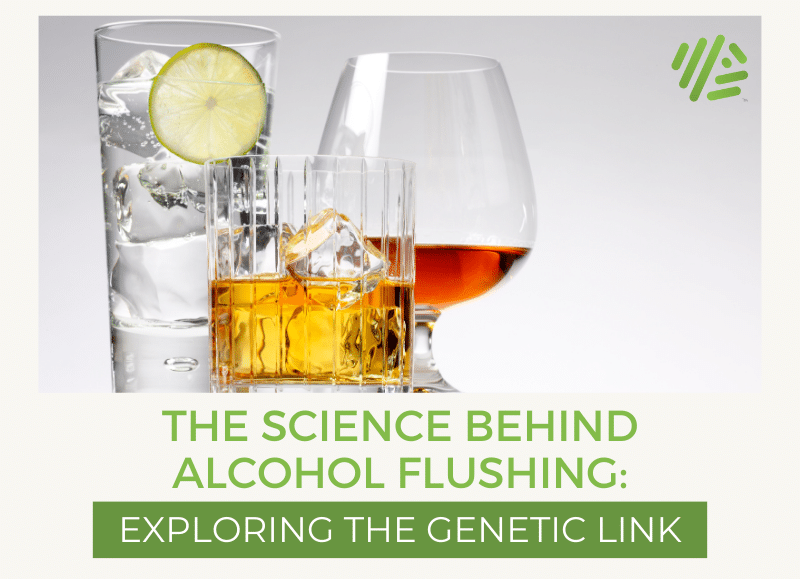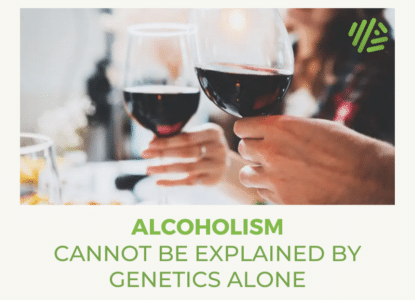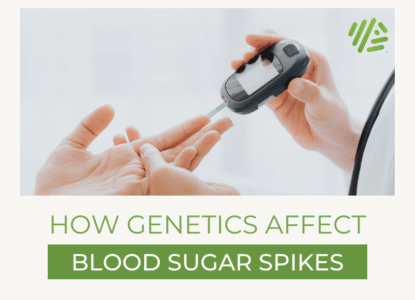The Science Behind Alcohol Flushing: Exploring the Genetic Link
Article at a Glance
- Alcohol flushing occurs as the result of genetic changes that cause some of us to metabolize alcohol more quickly than others.
Genes Mentioned

Contents
- What is Alcohol Flushing?
- Why Does Alcohol Cause Flushing in Some People?
- Is Alcohol Flushing Harmful?
- Who Experiences Alcohol Flushing?
- Is it possible to conduct laboratory testing to assess this among individuals?
- Can You Prevent Alcohol Flushing?
- What Should You Do If You Experience Alcohol Flushing?
- Conclusion
It is my job at Gene Food to review the scientific literature on alcohol metabolism, and other topics related to nutrigenomics, and rank the SNPs associated with the disorder based on the extent of the research. You can learn more about our process for including genes in our polygenic risk scores, on our Science Grade page.
In creating our alcohol risk score, I have been over several markers related to alcohol metabolism, and hope to distill my research in this blog post into something the layperson can find value from.
Picture this: You’re at a social gathering, and you decide to have a drink. Suddenly, your face turns bright red, you feel warm, and your heart races.
What’s going on?
In this Q&A-style blog, we’re here to unravel the mystery of alcohol flushing for you.
What is Alcohol Flushing?
Alcohol flushing, a condition that is most prevalent in East Asian populations, is a physical reaction that some people experience after consuming alcohol.
The flush reaction can include redness, warmth, nausea, and even dizziness.
Why Does Alcohol Cause Flushing in Some People?
Alcohol flushing occurs as the result of genetic changes that cause some of us to metabolize alcohol more quickly than others.
- Your body has enzymes called ALDH and ADH that metabolize alcohol (ethanol).
- During the breakdown of ethanol in your body, initially, ethanol is transformed into acetaldehyde by the enzyme ADH, and subsequently, acetaldehyde is further converted into acetate by ALDH, which is safely cleared by your body.
- Some of us possess specific functional genetic variations in ADH1B, like ADH1B2 (Arg48His or rs1229984) and ADH1B3 (Arg370Cys or rs2066702), which accelerate the conversion of ethanol into acetaldehyde.
- Conversely, some others have a functional variant in ALDH2, referred to as ALDH2*2 (Glu504Lys or rs671), which essentially impairs the body’s ability to metabolize acetaldehyde.
- This leads to the build up of acetaldehyde in the bloodstream, resulting in facial flushing, which is characterized by an elevated heart rate and increased blood circulation to the face due to the dilation of blood vessels.
Additionally, disulfiram, a medication utilized for addressing alcohol use disorders, modifies alcohol metabolism in a way that causes an accumulation of acetaldehyde when an individual consumes alcohol.
See also: Why we tend to choose partners based on drinking habits
Is Alcohol Flushing Harmful?
While the flushing itself isn’t harmful, it’s a signal.
Your body is telling you it’s not handling alcohol well, and specifically, that you do a poor job of managing the waste products of alcohol metabolism.
Prolonged exposure to acetaldehyde elevates the risk of developing certain cancers, such as esophageal cancer (40-80% higher risk).
This heightened risk is attributable to the carcinogenic nature of acetaldehyde (group 1 carcinogen) itself.
Who Experiences Alcohol Flushing?
Although it’s more common in people of East Asian descent, with approximately 30 to 50% of individuals carrying the functional variants, anyone can experience alcohol flushing if they have the right genetic makeup. It’s like a genetic lottery – some win the flush, while others don’t.
A large-scale meta analyses that studied the presence of the ADH1B2 SNP in African and European populations found that the mutation was protective against alcoholism.
Is it possible to conduct laboratory testing to assess this among individuals?
A straightforward method for detecting ALDH2 deficiency in individuals involves an ethanol patch test. This test entails applying ethanol to a Band-Aid, which is then affixed to the skin for a duration of 20 minutes. The dilation of blood vessels, essentially the trigger for the flushing reaction, is induced by acetaldehyde.
Those possessing the mutation will exhibit a red spot in the treated area. The ethanol patch test offers an accuracy rate of approximately 70% to 90%.
Can You Prevent Alcohol Flushing?
Not if you carry the risk variants for alcohol metabolism SNPs, no.
An antihistamine can potentially stop skin flushing by reducing blood vessel dilation. However, it doesn’t lower acetaldehyde levels in the blood and is not recommended as it involves bypassing your body’s natural way of signaling you to stop drinking by experiencing discomfort.
The best solution to minimize flushing is to limit your alcohol intake or choose drinks with lower alcohol content.
Hydration can help, too.
What Should You Do If You Experience Alcohol Flushing?
Listen to your body. If you flush and feel uncomfortable, it’s a good sign to slow down or stop drinking. Pay attention to your alcohol tolerance, and never ignore those warning signs.
Research shows that the rapid buildup of acetaldehyde in those who experience alcohol flushing acts as a powerful deterrent for excessive alcohol consumption. Put simply, if you experience flushing when consuming alcohol, you are likely to drink less, or not at all.
Conclusion
Alcohol flushing is like a secret code your body uses to tell you how it deals with alcohol.
It’s a fascinating combination of genetics and biology. Remember, it’s not just about the red face – it’s about understanding your unique response to alcohol and making informed choices.
So, next time you experience the “glow,” you’ll know it’s your genes talking, and it’s okay to take it easy on the drinks! Cheers to a colorful, flush-aware future!



